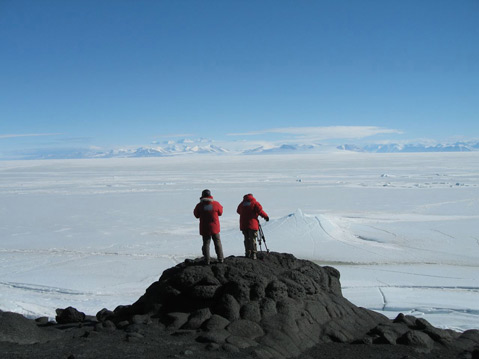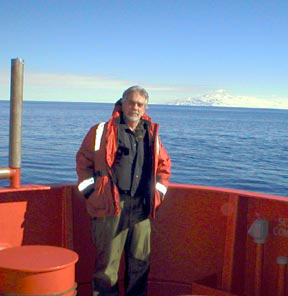Memories of McMurdo
UCSB Geophysicist Remembers Antarctica on Verge of Encounters at the End of the World's Santa Barbara Screening

With Werner Herzog’s Antarctic documentary Encounters at the End of the World screening at UCSB’s Campbell Hall on October 15 [CORRECTION: thanks to an astute reader, we now realize this is not the S.B. premiere], we asked geophysicist Bruce Luyendyk to relay some of his memories of McMurdo Station and other parts of Antarctica. Some of those memories are included in the print preview of the story, which you can see here, but we decided to share them all with our online readers, because they’re a candid look at life at the end of the world.
I first arrived in McMurdo in November 1989. This was pre-Internet. Making a phone call meant traveling over to New Zealand Scott Base and signing up to use their phone. It is different now – you can Web surf anywhere in town. I made eight visits between 1989 and 2004.

Getting there is not easy. Usually it starts by waiting in Christchurch, New Zealand, until the weather is suitable. My first trip, that wait was seven days. They use C-141’s now, but I made many trips down in Hercules with skis.
Once underway south, the critical part of the flight is reaching what is called the point of safe return (PSR) about four hours out in a Herc and three hours in a jet. Here, the weather is checked ahead, and if it looks okay, you continue on. If not, you go back to New Zealand and start waiting once again for the weather. Of course, the weather can close-in after you have checked it. That means landing in whiteouts, usually.
McMurdo as a town is pretty bleak under the best of circumstances. Noticeable are the lack of trees or anything growing, and outdoor advertising. Heavy equipment and trucks are constantly moving around the streets of crushed volcanic ash making clouds of dust. People walking around in bad weather need to be careful if they have hoods pulled up on their parkas as you cannot hear the vehicles or see them coming from the sides of your vision.
Many people are in town to go elsewhere: the South Pole, Dry Valleys, field camps, or into the wilderness – if you can imagine anything more wild. I was usually in transit to a wilderness trail party or waiting for a research icebreaker. There are two classes of people: “beakers,” or scientists; and the rest, consisting of contractors or military (usually from the Navy and Air Force).
The contractors are a mix of mostly younger people looking for adventure and thinking this is the gateway. What they find is a lot of hard work under challenging conditions and restrictions on their movements by the governing authority of the U.S. National Science Foundation. Scientists visit for a few weeks or a couple of months. Contractors are there for the season-usually four to six months. A few extreme individuals are there to “winter over.” Those individuals who choose to return for multiple seasons have found a place in which only a few fit in.
Accommodations are in dormitories. Some rooms, particularly for the transients, are crowded and grim. If you are more ranking, you get to share a room with a resident and it will have a shared bathroom. You need to bring your own towel, as there is no laundry service. Many people forget that and I have seen them drying off in the shower rooms with paper towels.
Entertainment focuses on events at a few bars that close late at night. After drinking for a while until 12 or 1 a.m., it is a shock to step out into full daylight on the streets. Sleeping requires eyeshades and earplugs; pretend it is dark and that it is not blowing hard and rattling the walls.
Eating is in a mess hall. At first, it was Navy-style and segregated into Navy officers on one side and the rest of us on another. Now it is joined. Food is varied and plentiful. People keep their ears open for the arrival of “freshies,” meaning fresh vegetables flown down from New Zealand.
McMurdo is usually crowded in November and January as people come and go from the station. You can end up sleeping on the floors and waiting for days to get back to the world, as again, the weather rules.
4•1•1
Encounters at the End of the World screens at UCSB’s Campbell Hall on Wednesday, October 15, 7:30 p.m. Call 893-3535 or see artsandlectures.sa.ucsb.edu. For more on Bruce Luyendyk’s research, see his website here.



